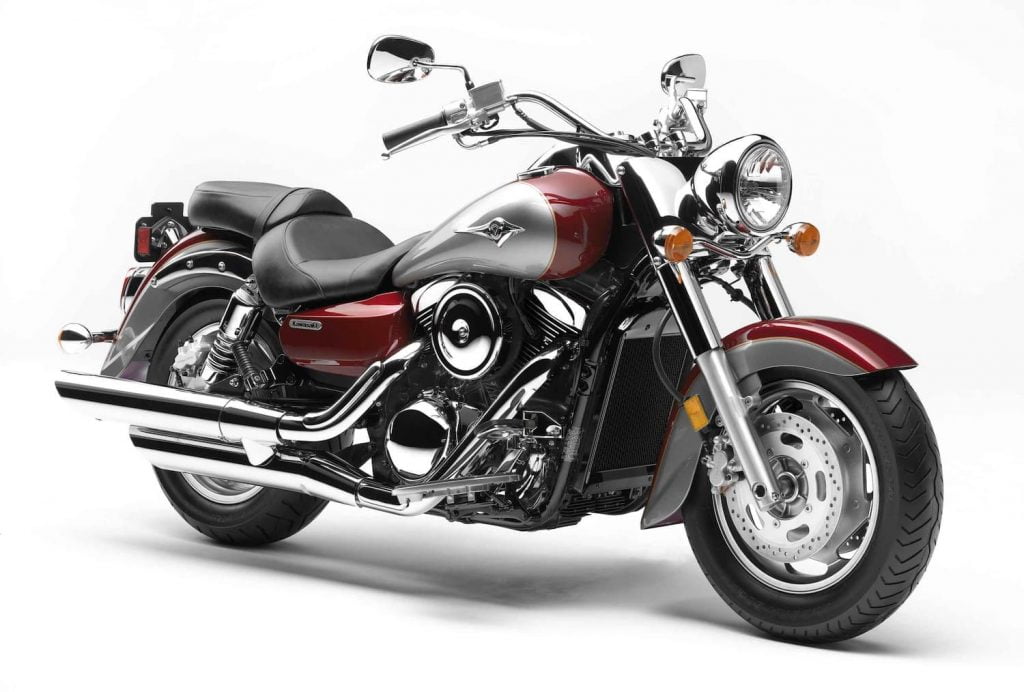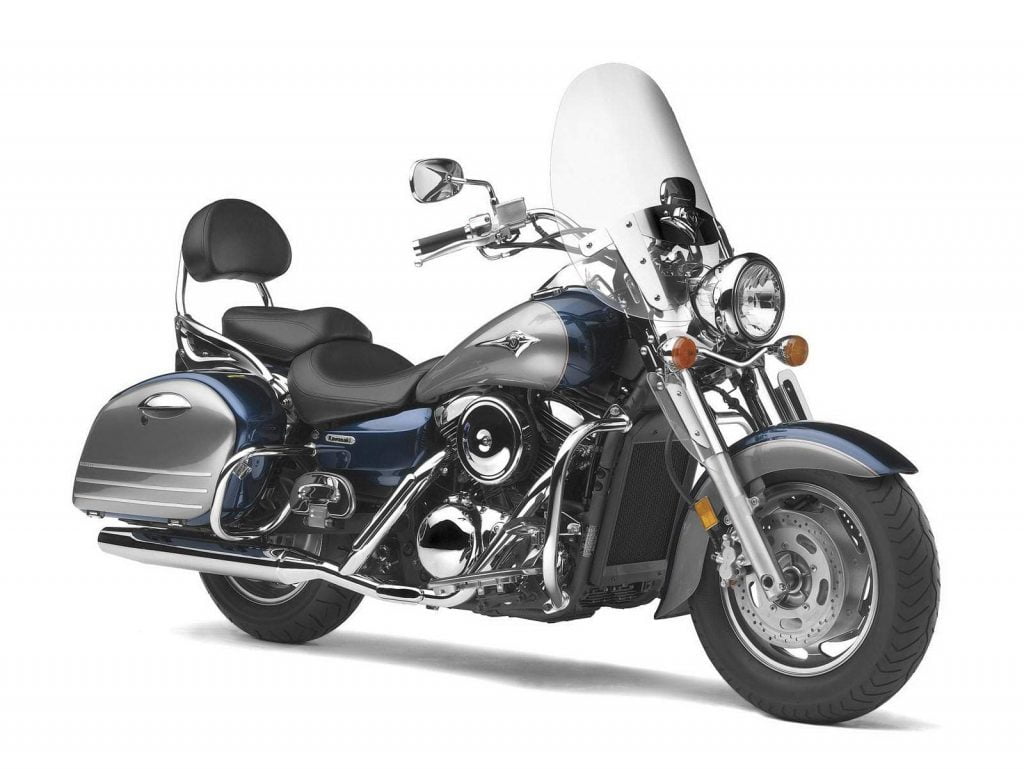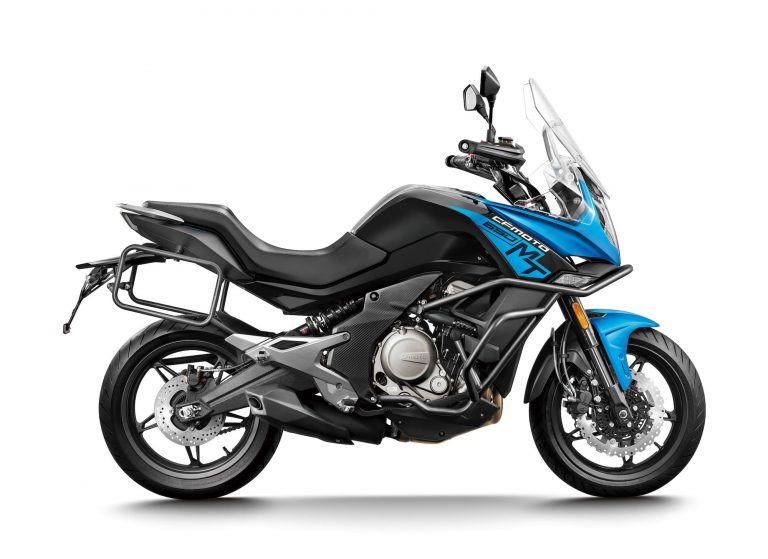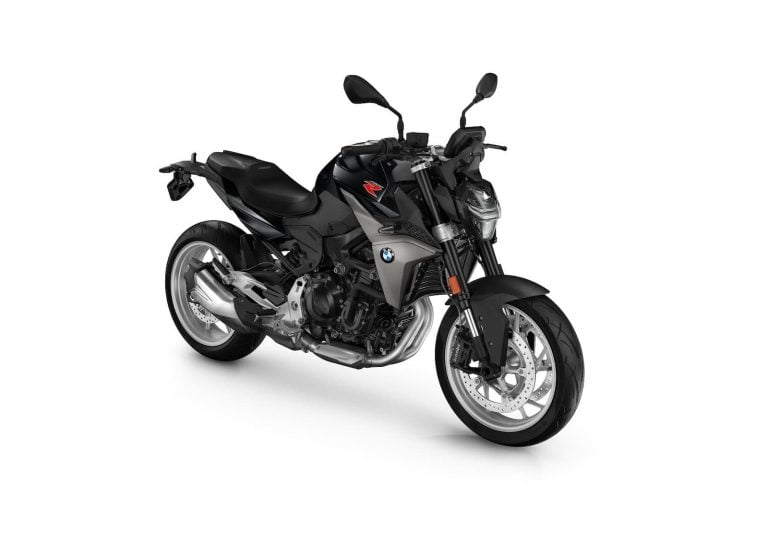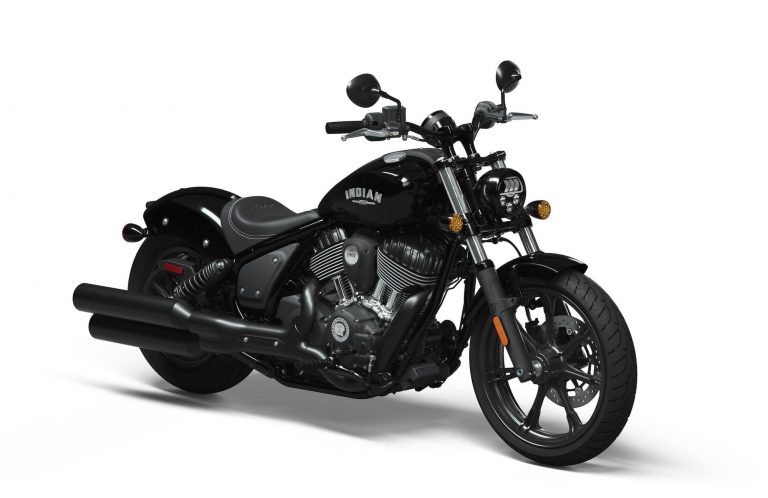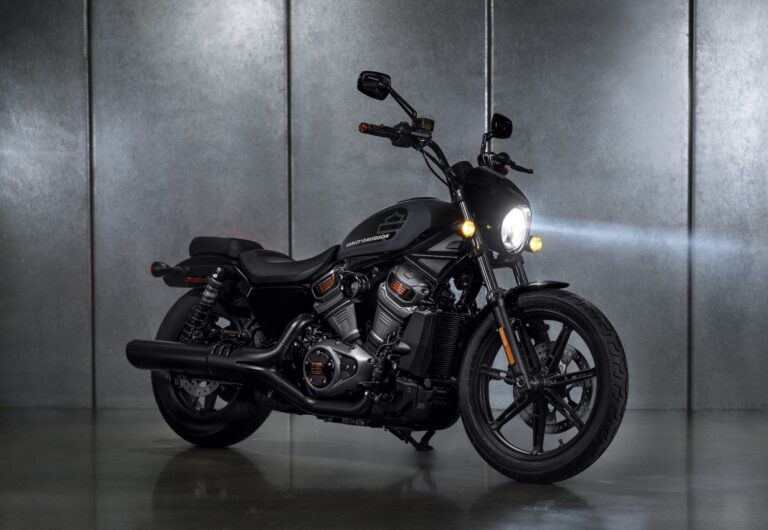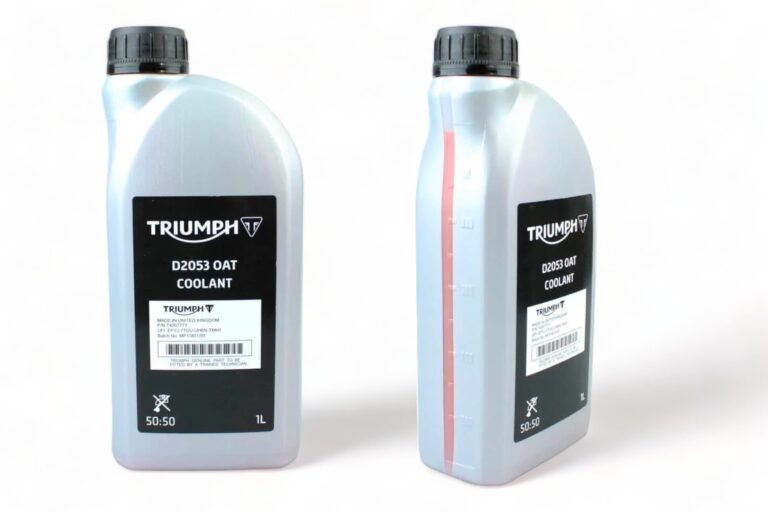Kawasaki Vulcan 1600 (Classic and Nomad, 2003-2008) Maintenance Schedule and Service Intervals
This is the maintenance schedule with associated service intervals for the Kawasaki Vulcan 1600 range of motorcycles, including the Classic and Nomad, made between 2001 and 2008 — the VN1600 line.
The Vulcan is Kawasaki’s name for their cruiser, tourer, and bagger range. The Vulcan 1600 is an update to the Vulcan 1500 FI. While the 1500 engine came in both carburettor-fed and fuel injected forms, the 1600 is all fuel injected.
The Kawasaki Vulcan 1600 range is powered by a 1,552 cc (barely rounds up to 1600!) liquid-cooled SOHC fuel-injected V-twin engine with two spark plugs per cylinder. The motorcycles have five-speed transmissions and shaft drives.
Here are the differences between the motorcycles in the range:
- Kawasaki Vulcan 1600 Classic (2003-2008): The baseline, classic cruiser. The 1600 Classic was replaced by the 1700 Classic in 2009.
- Kawasaki Vulcan 1600 Nomad (2005-2008): The version with the touring windscreen and luggage. The engine is otherwise identical.
- Kawasaki Vulcan 1600 Mean Streak (2004-2008): Tuned for about 3kW/5hp more power (with different cam profiles and fuelling), with more aggressive rake, inverted forks, and different tyres, for sportier handling. The ride is quite different.
The Mean Streak has some different aspects to its maintenance schedule, so I’m keeping it separate.
This site has links for things like oil and spark plugs from which we earn a commission (which unfortunately nobody can save, not even us). If you appreciate this work, then please use those links. Thanks!
Kawasaki Vulcan 1600 Service Intervals
The Kawasaki Vulcan 1600 may be one of the lowest-maintenance cruisers on the market.
General service intervals are every 3750 miles / 6000 km, at which point you should check the plugs and do a once-over of the safety systems, including the brake and clutch.
But you only need to change the oil every 7500 miles / 12000 km.
Since the Vulcan 1600 has hydraulic valve lash adjusters, you don’t need to ever check the valve clearances. Plus, it has a shaft drive, so there’s not even a belt to change!
The only fly in the ointment is the radiator, which means you have to change coolant every two years. But aside from that (and the brake fluid), owning a Vulcan 1600 is dead easy.
What you need to service your Kawasaki Vulcan 1600
Even though it’s a shaft-driven bike, you still have to do regular service on your Vulcan 1600.
Top priority are keeping the fluids changed — coolant, brake/clutch fluid, and gear oil (occasionally).
But thankfully, there’s no chain to maintain!
Here are the general consumables you’ll need to maintain your Kawasaki Vulcan 1600.
| Part | Kawasaki Vulcan 1600 Spec |
|---|---|
| Oil | You need SAE 10W-40 engine oil with API SH or SJ (or newer, e.g., SL or SM) with JASO MA rating, for example Kawasaki 10W-40 Engine Oil, or another high-grade oil like Motul 7100. Some owners (e.g. this thread) like Shell Rotella T6. Don’t over-torque the drain bolt (spec is 30 Nm/22 lb-ft per the manual) — use a torque wrench if you don’t have experience with how much torque is enough. |
| Oil filter | Use a Hiflofiltro filter for easy replacement, part HF204RC. Torque for oil filter is 18 Nm (13 ft-lb) (use a torque wrench, and it’s easier on the K&N one) |
| Final drive oil | Remember to change this periodically. It’s not hard! Use Mobil 1 Gear Oil, a popular choice. |
| Brake pads | Many riders upgrade to EBC HH brake pads (see this thread). These are the part numbers you need: Front Left: FA229HH Front Right: FA231HH Rear: FA231HH 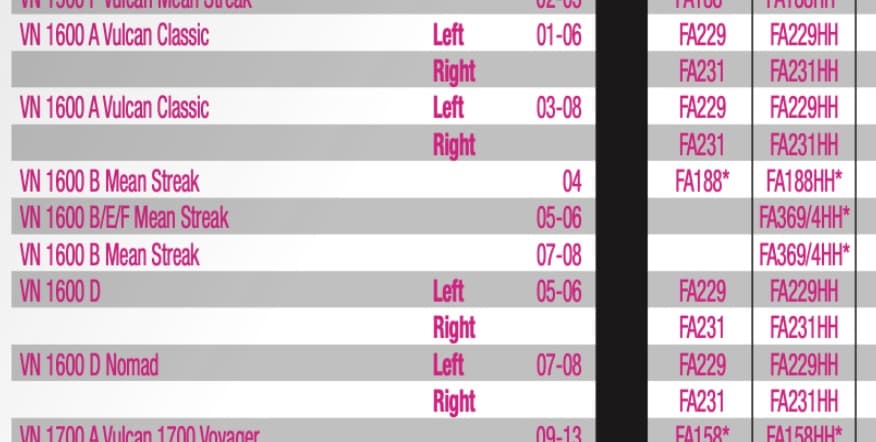 |
| Spark plugs | NGK DPR6EA-9, with a spark plug gap of 0.8-0.9mm (use a spark plug gapping tool), torqued to 18 Nm or 13 ft-lb (use a torque wrench). Remember you need four spark plugs as it’s a twin spark engine. (DPR6EA-9 4-pack)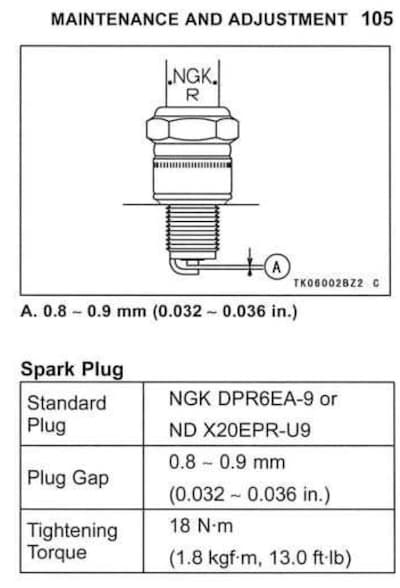 |
| Air filter | Most people replace the OEM air filter with a K&N aftermarket air filter (functionally identical). You can also use the K&N part KA-1603 for the Nomad and Classic. |
| Brake/Clutch fluid | Spec is to use DOT 4 brake/clutch fluid, e.g. Castrol DOT 4. |
| Coolant | Use, as ships with the Vulcan, 50/50 pre-mix of ethylene glycol-based coolant with anti-corrosion inhibitors, e.g. Valvoline Zerex G05 |
| Grease | Use a lithium soap based grease for all the important greasing points. |
Maintenance Schedule for Kawasaki Vulcan 1600 motorcycles
Below is the maintenance schedule for the Kawasaki Vulcan 1600. It’s taken straight from the manual for them and adapted to fit a website.
Having shaft drives and fuel injection, maintaining a Vulcan 1600 is a lot easier than it used to be! That said, replace your shaft drive with new gear oil 36,000 km (24,000 mi) or so… it’s surprising how many people don’t. Or if they do, do it with every oil change, obsessively (and unnecessarily).
The following is the list of maintenance operations and to be done on this motorcycle with a time or distance interval — whichever comes earlier.
Notes/Legend:
- For higher odometer readings, repeat at the frequency interval established here
- Kawasaki recommends items related to brakes, fuel, steering, and fluids be serviced by an authorised dealer.
- Items marked “Check”: Replace, adjust, or torque if necessary.
- Check brake pads, air filter, and engine oil condition more often when riding in harsh conditions.
- The break-in service is omitted.
| km x 1000 | 6 | 12 | 18 | 24 | 30 | 36 | |
|---|---|---|---|---|---|---|---|
| mi x 1000 | 4 | 7.5 | 12 | 15 | 20 | 24 | Every |
| Engine oil — change (Kawasaki 10W-40 Engine Oil or Motul 7100 10W-40) | ✓ | ✓ | ✓ | Year | |||
| Oil filter — replace (HF204RC) | ✓ | ✓ | ✓ | ||||
| Spark plug — clean and gap (replace with DPR6EA-9 if necessary) | ✓ | ✓ | ✓ | ✓ | ✓ | ✓ | |
| Air cleaner element — clean (replace with KA-1603 if necessary) | ✓ | ✓ | ✓ | More often if riding in harsh conditions | |||
| Brake/clutch fluid — change (use Castrol DOT 4) | ✓ | 2 years | |||||
| Idle speed — check | ✓ | ✓ | ✓ | ||||
| Throttle control system — check | ✓ | ✓ | ✓ | ✓ | ✓ | ✓ | |
| Air suction valve — check | ✓ | ✓ | ✓ | ✓ | ✓ | ✓ | |
| Evaporative emission control system — check | ✓ | ✓ | ✓ | ✓ | ✓ | ✓ | |
| Brake/clutch hoses, connections — check | ✓ | ✓ | ✓ | ✓ | ✓ | ✓ | |
| Brake light switch — check | ✓ | ✓ | ✓ | ✓ | ✓ | ✓ | |
| Brake pad wear — check | ✓ | ✓ | ✓ | ✓ | ✓ | ✓ | |
| Brake/clutch fluid level — check | ✓ | ✓ | ✓ | ✓ | ✓ | ✓ | Month |
| Fuel hose, connections — check | ✓ | ✓ | ✓ | ✓ | ✓ | ✓ | |
| Steering — check | ✓ | ✓ | ✓ | ✓ | ✓ | ✓ | |
| Final gear case oil level — check | ✓ | ✓ | ✓ | ||||
| Final gear case oil — change (use Mobil 1 Gear Oil) | ✓ | ||||||
| Propeller shaft joint – lubricate | ✓ | ✓ | |||||
| Nut, bolt, fastener tightness — check | ✓ | ✓ | ✓ | ||||
| Tire wear — check | ✓ | ✓ | ✓ | ✓ | ✓ | ✓ | |
| General lubrication—- perform (lithium soap-based grease) | ✓ | ✓ | ✓ | ||||
| Front fork oil leak — check | ✓ | ✓ | ✓ | ||||
| Rear shock absorber oil leak — check | ✓ | ✓ | ✓ | ||||
| Swingarm pivot – lubricate | ✓ | ✓ | |||||
| Coolant — change (Valvoline Zerex G05) | ✓ | 2 years | |||||
| Radiator hoses, connections — check | |||||||
| Steering stem bearing — lubricate | ✓ | 2 years | |||||
| Brake/clutch master cylinder cup and dust seal — replace | 4 years | ||||||
| Caliper piston seal and dust seal — replace | 4 years | ||||||
| Clutch slave cylinder piston seal — replace | 4 years |
Tyre size and tyre pressure for the Kawasaki Vulcan 1600
The Kawasaki Vulcan 1600 Classic and Nomad ship with Bridgestone Exedra or Dunlop D404 tyres.
The Kawasaki Vulcan 1600 motorcycles (Classic and Nomad) have following tire sizes standard (tubeless type):
| Wheel | Size | Pressure |
|---|---|---|
| Front | 130/90-16 M/C 67H | 200 kPa/28 psi |
| Rear | 170/70 B16 M/C 75H | 250 kPa/36 psi |
Be aware that the Mean Streak has different tyre specs. Don’t get the wrong ones!
About the Kawasaki Vulcan 1600 Nomad and Classic
The Kawasaki Vulcan 1600 range of motorcycles are Kawasaki’s bigger cruisers. They’re an upgrade to the Kawasaki Vulcan 1500, which ended with fuel injection, plus there are a number of other changes to improve overall rideability.
Both the Kawasaki Vulcan 1600 Nomad and Classic share the same platform (including the same engine with the identical state of tune), so maintenance for them is the same. However, maintenance for the Mean Streak is slightly different (some parts are different), so we’ve kept that separate.
Like most big Kawasaki cruisers, the Kawasaki Vulcan 1600 is a very relaxing motorcycle to ride, whether in Classic or Nomad form. The 1552 cc / 95 cubic inch liquid-cooled V-twin engine makes a ton of plenty of low-end torque, with more than enough power for just about anything.
The VN1600 motor has a mild state of tune in the Nomad and Classic, with a 9.0:1 compression ratio. At peak it makes 48 kW / 66 hp at 4700 rpm, and an imprssive 94 lb-ft / 127 Nm of torque at 2700 rpm. Final drive is via a shaft, which keeps maintenance low, though you do have to periodically change the shaft drive oil.
The engine’s power is complemented by its chassis. The front end suspension is a 41mm telescopic fork, and the rear suspension is dual air-assisted shocks, adjustable for rebound and preload.
The Vulcan 1600’s chassis is rigid but makes for very luxurious ride quality. Unlike some other shaky cruisers, the Vulcan is like a Cadillac on the highway — just smooth.
Even though this is a Japanese or “metric” cruiser, the Vulcan 1600 has lots of elements that make it an American-style classic. Huge amounts of chrome, dual slash-cut mufflers, deep paint, and a multi-reflector headlight are all just iconic design features.
And the Vulcan 1600 has just enough tach to keep you interested including an LCD screen, fuel gauge, and the standard clocks. Like on many cruisers, the instruments on the Vulcan 1600 are mounted on the tank.
In terms of maintenance, the VN1600’s engine has single overhead cams and hydraulic valve lash adjusters, which means no valve service intervals. Together with the automatic cam chain tensioner, the Vulcan 1600 will need very little maintenance.
You should get used to scraping, though. You’ll scrape floorboards all the time — around corners, around roundabouts, or out on the highway. The thing is, it’s fine. The bike is designed to scrape. It’s not begging to be thrown into corners, but when you start pushing it a little harder than it likes, it’ll let you know.
If you’re looking to do some distance, grab the Nomad. You’ll appreciate the screen and the standard bags!
Manual for the Kawasaki Vulcan 1600
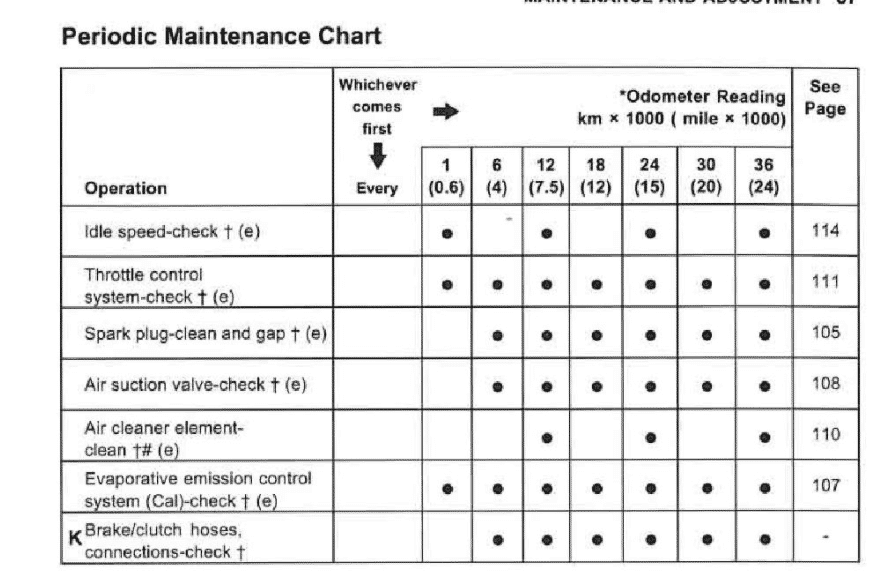
The above maintenance schedule comes directly from the user’s manual for the 2003-2008 Kawasaki Vulcan 1600 Classic, which is available here.
